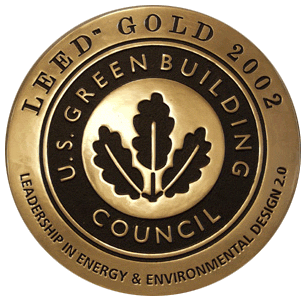The Leadership in Energy and Environmental Design (LEED) Green Building Rating System has been around now since 1998, and lots of people are talking about it. But just incase there are others out there like me (who talk alot about things they don’t know much about) I thought there could be some more to say about it here.

The LEED rating system was developed by the U.S. Green Building Council, and it has several different standards: LEED for residential, commercial, for new structures, existing structures, commercial interiors, retail, schools, etc. LEED is a third-party certification program that can be applied for after completion of construction. Anyone can apply for LEED status on any structure, but if LEED certification is to be achieved there are two important types of qualifications. First, the structure must meet all of the prerequisites for certification. Second it must achieve enough total points throughout the catagories that LEED assesses.
If any of the prerequisites are not met than the structure is disqualified right away. These can include things like ventilation systems to construction site pollution. If the structure meets all prerequisites then it must achieve a minimum number of points. For new commercial building (version 2.2) certification requires 26-32 points.
Here is where LEEDs ranking system comes into play. LEED commercial silver status requires 33-38 points, gold status requires 39-51 points, while platinum requires 52-69 points.
The rating system is finding acceptance worldwide, but will it work? The LEED system is developed by committees and these committees have agendas. Some of these agendas are being criticized. One such criticism is that LEED encourages too much use of fossil fuels. Another concern is that LEED’s requirements for older homes isn’t economical or affordable for the majority of Americans. Is it the sustainable path to encourage all Americans to remodel their seventy year old bungalows to qualify for LEED certification? These homes, build by the thousands all over America, have innately poor circulation, and this is an important prerequisite for certification.
It certainly seems that the LEED system is here to stay. A positive for the rating system is that it should be able to flex and adapt affectively as more people become aware of it and participate in implementing it world-wide. Find out more at the U.S. Green Building Council’s page.
The LEED system is imperfect at best. And as we’ve discussed before it certainly falls short in promoting green renovation with existing homes for the average American looking to do something positive with their existing home. However I am personally glad that LEED has gained traction and even some glam for new and commercial construction and I hope it can continue to grow in these areas.
If only something could come along to deal with the real issue of sustainability in housing… what to do with existing homes.
Thanks for the comment Seth. Maybe Van Jones’ campaign for the “Green Collar Economy” will catch on, and more of the unemployed will be given caulking guns and insulation for all our ancient bungalows and such. Have fun in-filling insulation in your new place by the way.